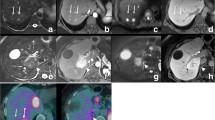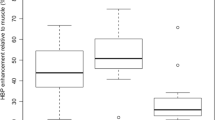Abstract
Objective
To compare hepatocellular phase imaging after intravenous gadoxetate disodium with other MRI pulse sequences and with extracellular agent for assessing hepatic metastases from gastroenteropancreatic neuroendocrine neoplasms (GEP-NEN).
Materials and methods
In this IRB-approved, HIPAA-compliant retrospective study, we included 30 patients (15 women, mean age: 58 years, range 44–77 years) with GEP-NEN metastatic to the liver, who underwent MRI with gadoxetate disodium. Six MRI sequences were reviewed by two radiologists to score tumor–liver interface (TLI) on a 5-point scale, to assess lesion detectability in different liver segments (divided into 3 zones/patient), and to measure lesion size. Contrast-to-noise ratio (CNR) was calculated on each sequence. In 19 patients, lesion size and CNR on dynamic imaging with gadopentetate dimeglumine was compared with hepatocellular phase. Wilcoxon signed-rank test was used to compare TLI scores, lesion size, and median CNR, using Bonferroni correction for multiple testing. Interobserver agreement for TLI was analyzed using Krippendorff's alpha, and for lesion size using concordance correlation coefficient (CCC) and mean relative difference.
Results
Hepatocellular phase had the best TLI (mean TLI for reader 1 = 1.2, reader 2 = 1.3) compared to all other sequences (p < 0.0001) with excellent interobserver agreement (Krippendorff's alpha = 1.0), maximum lesion detectability (61/90 zones), highest interobserver agreement for lesion measurement (CCC 0.9875 and smallest mean relative difference − 1.567%), and highest median CNR (31.2, p < 0.008). Hepatocellular phase also had the highest CNR when compared with gadopentetate imaging.
Conclusion
Hepatocellular phase imaging offers significant advantages for assessment of hepatic metastasis in GEP-NEN, and should be routinely considered for follow-up of these patients.



Similar content being viewed by others
References
Neri E, Bali MA, Ba-Ssalamah A, et al. (2016) ESGAR consensus statement on liver MR imaging and clinical use of liver-specific contrast agents. Eur Radiol 26(4):921–931
Donati OF, Fischer MA, Chuck N, et al. (2013) Accuracy and confidence of Gd-EOB-DTPA enhanced MRI and diffusion-weighted imaging alone and in combination for the diagnosis of liver metastases. Eur J Radiol 82(5):822–828
Kim YK, Lee MW, Lee WJ, et al. (2012) Diagnostic accuracy and sensitivity of diffusion-weighted and of gadoxetic acid-enhanced 3-T MR imaging alone or in combination in the detection of small liver metastasis (≤ 1.5 cm in diameter). Investigative radiology 47(3):159–166
Sankowski AJ, Cwikla JB, Nowicki ML, et al. (2012) The clinical value of MRI using single-shot echoplanar DWI to identify liver involvement in patients with advanced gastroenteropancreatic-neuroendocrine tumors (GEP-NETs), compared to FSE T2 and FFE T1 weighted image after i.v. Gd-EOB-DTPA contrast enhancement. Med Sci Monit 18(5):MT33-40
Flechsig P, Zechmann CM, Schreiweis J, et al. (2015) Qualitative and quantitative image analysis of CT and MR imaging in patients with neuroendocrine liver metastases in comparison to (68)Ga-DOTATOC PET. Eur J Radiol 84(8):1593–1600
Giesel FL, Kratochwil C, Mehndiratta A, et al. (2012) Comparison of neuroendocrine tumor detection and characterization using DOTATOC-PET in correlation with contrast enhanced CT and delayed contrast enhanced MRI. Eur J Radiol 81(10):2820–2825
Mayerhoefer ME, Ba-Ssalamah A, Weber M, et al. (2013) Gadoxetate-enhanced versus diffusion-weighted MRI for fused Ga-68-DOTANOC PET/MRI in patients with neuroendocrine tumours of the upper abdomen. Eur Radiol 23(7):1978–1985
d’Assignies G, Fina P, Bruno O, et al. (2013) High sensitivity of diffusion-weighted MR imaging for the detection of liver metastases from neuroendocrine tumors: comparison with T2-weighted and dynamic gadolinium-enhanced MR imaging. Radiology 268(2):390–399
Dromain C, de Baere T, Baudin E, et al. (2003) MR imaging of hepatic metastases caused by neuroendocrine tumors: comparing four techniques. Am J Roentgenol 180(1):121–128
Dromain C, de Baere T, Lumbroso J, et al. (2005) Detection of liver metastases from endocrine tumors: a prospective comparison of somatostatin receptor scintigraphy, computed tomography, and magnetic resonance imaging. J Clin Oncol 23(1):70–78
Morse B, Jeong D, Thomas K, Diallo D, Strosberg JR (2017) Magnetic resonance imaging of neuroendocrine tumor hepatic metastases: does hepatobiliary phase imaging improve lesion conspicuity and interobserver agreement of lesion measurements? Pancreas 46(9):1219–1224
Freelon D (2013) ReCal OIR: ordinal, interval, and ratio intercoder reliability as a web service. Int J Internet Sci 8(1):10–16
Freelon D (2010) ReCal: Intercoder reliability calculation as a web service. Int J Internet Sci 5(1):20–33
Krippendorff K (1970) Estimating the reliability, systematic error, and random error of interval data. Educ Psychol Meas 30:61–70
Baur A, Pavel M, Prasad V, Denecke T (2016) Diagnostic imaging of pancreatic neuroendocrine neoplasms (pNEN): tumor detection, staging, prognosis, and response to treatment. Acta Radiol 57(3):260–270
Davenport MS, Caoili EM, Kaza RK, Hussain HK (2014) Matched within-patient cohort study of transient arterial phase respiratory motion-related artifact in MR imaging of the liver: gadoxetate disodium versus gadobenate dimeglumine. Radiology 272(1):123–131
Pietryga JA, Burke LM, Marin D, Jaffe TA, Bashir MR (2014) Respiratory motion artifact affecting hepatic arterial phase imaging with gadoxetate disodium: examination recovery with a multiple arterial phase acquisition. Radiology 271(2):426–434
Eisenhauer EA, Therasse P, Bogaerts J, et al. (2009) New response evaluation criteria in solid tumours: revised RECIST guideline (version 1.1). Eur J Cancer 45(2):228–247
Author information
Authors and Affiliations
Corresponding author
Ethics declarations
Disclosures
No disclosures.
Grant support
None.
Additional information
Scientific Guarantor: Atul B. Shinagare, MD.
Appendix
Rights and permissions
About this article
Cite this article
Tirumani, S.H., Jagannathan, J.P., Braschi-Amirfarzan, M. et al. Value of hepatocellular phase imaging after intravenous gadoxetate disodium for assessing hepatic metastases from gastroenteropancreatic neuroendocrine tumors: comparison with other MRI pulse sequences and with extracellular agent. Abdom Radiol 43, 2329–2339 (2018). https://doi.org/10.1007/s00261-018-1496-1
Published:
Issue Date:
DOI: https://doi.org/10.1007/s00261-018-1496-1




